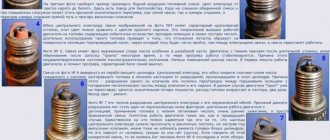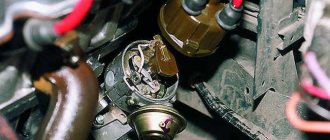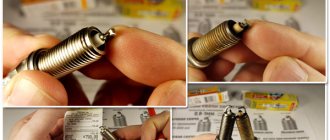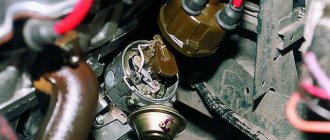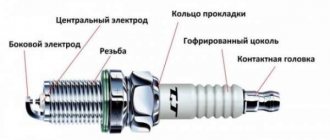Hello everyone)) in short, I had a distributor with a contact group, an old ignition coil and dead explosive wires
all this gave a Red spark ((((I’ll explain for those who don’t know - there are two types of spark: Blue and Red
So, a Blue spark means that the ignition system is working perfectly and the spark is strong and will ignite the mixture well, while the Red spark is weak. therefore it ignites the fuel mixture worse ((
There are many reasons why the spark can be red - in my case, the overall output of the units
due to the fact that I decided to exchange everything old for a new one, I bought a contactless ignition kit and new explosive wires
but then a problem appeared (((in the kit, the rod of the distributor (ignition distributor) turned out to be shorter than the original one - BUT I’m not going to give everything I bought to the store because of this))) we take two distributors, a screwdriver, pliers and swap the rods)))
everything is as it should be! put everything in its place and start! WOW, the spark is strong, BLUE, the engine starts with a kick and runs cleanly and without failures))
The quality of the spark on the spark plugs is checked in the same way as in its absence. However, it is advisable to change the gap with the high-voltage spark plug wire and ground. A spark is considered good if it penetrates a gap of at least 7 mm.
A weak spark on the spark plugs is a malfunction that occurs in the same way as when there is none at all, but it is much more difficult to detect the cause of its occurrence. An ammeter won't even be able to help in this case. The best way to determine a malfunction is to turn off a particular device or section of the circuit from the ignition system and try, if possible, to get a spark without them. The appearance of a good spark indicates a malfunction of the switched off device.
When, after checking, it turns out that the spark between the spark plug and the high-voltage wire is weak, turn off the distributor from the ignition circuit and check the quality of the spark between the ground and the high-voltage wire of the ignition coil. The presence of a strong spark indicates that the entire ignition system to the distributor is working, except for the distributor cap, rotor or high-voltage spark plug wires. If these parts are cracked or broken, they must be replaced.
If, when disconnecting the distributor, the spark remains weak, as before, you should carefully check all the clamps of the low voltage circuit, the cleanliness and reliability of the fastening. If, even after checking the terminals, the spark is weak, it is necessary to turn off the breaker from the low voltage circuit. Its action can be replaced with an additional wire, one end of which is connected to the point of connection of the capacitor wire with the low voltage wire coming from terminal P of the ignition coil, and the other is sharply struck to ground. In this case, the ignition coil wires and the capacitor must be disconnected from terminal K of the breaker.
Spark test
ATTENTION! A completely simple way to reduce fuel consumption has been found! Don't believe me? An auto mechanic with 15 years of experience also didn’t believe it until he tried it. And now he saves 35,000 rubles a year on gasoline! Read more"
It is recommended to test the spark in a dry room, such as a garage. There is no need to use any additional devices or complex equipment.
The ideal result is when the candle emits a bright blue color. In all other cases, when the color is white, red or another, there is something wrong with the system. The spark must be powerful, confident, appear constantly, and not periodically. The spark shouldn't be pink either.
If there is no spark at all, and the distributor is fully operational, it is recommended to check the spark plug itself directly. For example, you can install a known good one instead of the spark plug being tested.
On an injector, if the engine runs intermittently in idle mode or its power noticeably decreases, it is customary to talk about problems with the spark plugs. The Check Engin indicator can provide important information.
There is no spark in the VAZ 2110 injector 8 valves: we will analyze the problem step by step
Very often, car owners discover that there is no spark in the VAZ 2110 injector 8 valves. In most cases, they have to look for the cause of the failure on their own. Of course, you can go to the nearest workshop for this purpose, but who wants to spend extra money for diagnostics.
Especially if the car is more valuable than life, and the car enthusiast does not want to trust it into the wrong hands. A strong argument in favor of independent intervention is that the design of VAZ engines is not that complicated, and anyone who has delved at least once into the carburetor of domestic cars should not be afraid of the injector. There is no spark in the VAZ 2110 injector 8 valves - and this worries you greatly.
In order to find out the reason, you need to examine several important nodes step by step. Although a person who is not the first time encountering injector malfunctions can easily determine the cause. To do this, he will need a lamp controller, a multimeter and a spark gap. Step one The most common sign of an injector disease is the following: the starter functions as usual, but the power plant does not want to start.
The reason for this is most likely a malfunction of the fuel pump, which is usually accompanied by a characteristic rattling noise. You also need to check the fuses. On old VAZ models they were installed under the glove compartment. In modern cars, manufacturers place the fuses on the panel, near the passenger. You need to unscrew the fastening bolts, remove the cover, check the elements and, if necessary, replace them. If the fuses have nothing to do with it, then you need to check the relay - both the main one and the fuel one. A click is heard, and the contact is felt with your finger - that means everything is fine with it. After you have verified that the fuel unit is working, you need to check with a pressure gauge whether there is any fuel left in it.
If the device is missing, you can simply press the spool, which will help determine the approximate level. If your car's engine is running, but the pump pressure is zero, then most likely the gasoline lines and filters are clogged. In most cases, the cause of this is poor quality fuel.
Step two It is logical to assume that if there is no spark, then the reason should be sought in the spark plugs, especially if there are no complaints about the fuel pump. To check them properly, you must have a spark gap available. So, if it was possible to detect that current is simultaneously supplied to 2 spark plugs, this means that there is a breakdown to ground.
If there is no contact on several wires at once, then the reason may lie in a breakdown of the controller or ignition module. The cause may also be a break in the high voltage wire. To check this, you need to measure the resistance. In normal condition, its value should not exceed the 200 kOhm level. Also, you need to pay attention to the resistance of individual wires, which should not differ much.
To confirm or refute the malfunction of the module and ignition coil, you need to immediately check the error codes on the on-board computer. If the equipment level of your car does not allow this, then it is better to immediately replace the suspicious elements with new ones. Most likely, the reason for the lack of spark is a breakdown of the controller or a break in the wires that connect it to the coil.
If you notice that there is no spark on any of the coils, then they all need to be replaced immediately. And if there is no discharge yet, then you urgently need to determine whether there is power. It is worth remembering that if the system includes a module, then you also need to make sure that the minus is in place. Step Three By this point, we have already found out that the pump is functioning normally, there is pressure in it, the spark plugs are producing sparks, but the power plant still refuses to start.
Most likely, the reason lies in a violation of the technology for installing the deposit disk. You can find it on the crankshaft pulley. The main feature of the disk is that it lacks two teeth, and this is not just so - this void is the operating interval of the sensors. And if it is broken, the power unit will not start. Moreover, if the rubber band of the damper breaks and the place where the key is installed is broken. If, even after all the measures described above, it was not possible to find out why there is no spark in the VAZ 2110 injector 8 valves, then most likely the cause of the breakdown lies in the power plant itself.
Therefore, you need to immediately begin checking the pistons and cylinders, and then inspect the gas distribution system. There is no need to do anything else and it is better to seek help from specialists. And in general, if you are not confident in your competence, it is better to immediately take the car to a service center and not complicate your life.
Loss of spark on a 16-valve VAZ-2112 may be a consequence of the failure of several vehicle components at once or each individually. But, if the operations indicated in the article did not help, then you should contact specialists at a car service center who will accurately identify the cause and eliminate it.
Spark color
Thus, based on the color of the spark from the candles, the following conclusions can be drawn.
- If the color is white with a blue tint, the spark is constant, then everything is fine.
- If the spark is purple or transparent, colorless, you can draw conclusions about damage to the module, distributor or armored wires. Such a spark is knocked out at intervals or appears 1-2 times during testing.
- A red or yellowish color indicates the presence of additives in the fuel.
Red soot
Red carbon deposits are another common type of “spraying”. Usually, such a deposit does not mean that the engine is faulty, but is the effect of special additives. As you know, there are many different additive components in oil and fuel - they give the candle a reddish tone. Although when the ratio of additives is observed and the necessary standards are taken into account, deposits should not appear. The worse the quality of the oil (gasoline), the brighter the soot will be. It can even resemble rust. What kind of additives can create a similar redness effect? If we are talking about oil, then these are detergent additives. Although it is very difficult to make an accurate diagnosis here. When red carbon deposits appear, there is no need to do any diagnostic or repair work on the engine. All you need to do is change the oil, fuel and spark plugs (or just spark plugs).
Candles
The appearance of the spark, its color, is also influenced by the candle itself and its condition.
Table: condition and appearance of candles
| Candle condition | Decoding |
| Normal spark plug – the color of the deposits on the insulator (the skirt of the central electrode) is light brown or coffee; soot and deposits are minimal. Complete absence of oil traces. Moderate electrode burnout. | The owner of this engine can only be envied, and there is something to be desired - economical fuel consumption and the absence of the need to add oil from replacement to replacement. |
| The central electrode is covered with velvety black soot - dry soot. A typical example of a spark plug from an engine with high fuel consumption. | Rich air-fuel mixture - injector malfunction - malfunction of the engine control system (for example, failure or incorrect readings of the oxygen sensor), malfunction of the air damper drive mechanism, clogged air filter. |
| The color of the electrode is from light gray to white. | An example of an excessively lean air-fuel mixture. |
| The skirt of the central electrode of the spark plug has a characteristic reddish tint; this color can be compared to the color of red brick. | This redness is caused by the engine running on fuel containing an excessive amount of metal additives. Long-term use of such fuel will cause metal deposits to form a conductive coating on the insulation surface, through which it will be easier for current to pass than between the electrodes of the spark plug, and the spark plug will stop working. This deposit on the spark plug is most typical when using mangene additives in gasoline, which are used to increase the octane number of the fuel. |
| Pronounced traces of oil are black oily deposits, especially in the threaded part. | As a rule, this indicates an incorrect temperature regime in the direction of insufficient spark plug temperature or engine oil getting into the cylinder. Possible malfunctions: incorrect selection of spark plug (too “cold” spark plug), wear of valve guides, valve stem seals, piston rings. There is increased oil consumption. In the first minutes of engine operation, at the moment of warming up, there is a characteristic white and blue exhaust. |
| The central electrode and its skirt are covered with a dense layer of oil mixed with drops of unburned fuel and small particles from the destruction that occurred in this cylinder. | The reason for this is the destruction of one of the valves or the breakage of the partitions between the piston rings with metal particles getting between the valve and its seat. In this case, the engine “troubles” incessantly, a significant loss of power is noticeable, fuel consumption increases by one and a half, two times. There is only one way out - repair. |
| Complete destruction of the central electrode with its ceramic skirt. | The cause of this destruction could be one of the following factors: prolonged operation of the engine with detonation, the use of fuel with a low octane number, very early ignition, or simply a defective spark plug. The engine operating symptoms are the same as in the previous case. The only thing you can hope for is that the particles of the central electrode managed to slip into the exhaust system without getting stuck under the exhaust valve, otherwise repairing the cylinder head cannot be avoided. |
| Destruction of the ceramic insulator. | Causes of occurrence: a sharp change in temperature, for example when a spark plug unscrewed from a hot engine is cooled in cold water. In some cases, destruction may be caused by a defect in the candle itself (defective or counterfeit), or mechanical damage, for example as a result of a fall |
| The spark plug electrode is overgrown with ash deposits; the color does not play a decisive role, it only indicates the operation of the fuel system. | The reason for this build-up is oil combustion due to wear-out or jamming of the oil scraper piston rings. The engine has increased oil consumption, when over-gasping, there is strong blue smoke from the exhaust pipe, and the exhaust smell is similar to that of a motorcycle. |
| Spraying a spark plug with gasoline. | Often occurs due to a faulty injector. In winter, this can occur due to the fact that gasoline entering the combustion chamber does not have time to evaporate and settles on the spark plugs and cylinder walls. |
Light electrodes
White or light gray spark plugs in all cylinders are a sign of a lean air-fuel mixture supplied by the injector or carburetor. Moreover, the skirt, area near the electrodes and the threaded part are absolutely dry, without traces of oil.
- lambda - the probe incorrectly informs the control unit about the amount of oxygen in the exhaust gases, the reason is sensor wear;
- faulty or clogged nozzles;
- incorrect carburetor settings or clogged fuel jets;
- insufficient pressure in the injector fuel rail;
- problems with the idle air control;
- air leakage under the manifold or in another place;
- unsuccessful chip tuning of the controller made by the owner of the car.
A lean mixture does not pose any particular danger to a running engine, but it does cause discomfort to the driver. The car accelerates slowly, pulls poorly and jerks - there is a lack of fuel. Oddly enough, the phenomenon causes increased gasoline consumption - a car enthusiast who wants to achieve better performance indicators presses the accelerator pedal harder and more often.
Reason #5 – Burnout of transistors in the ECU
The lack of a spark can also be explained by broken transistors in the VAZ electronic control unit. To detect faulty elements, you will need to dismantle the controller and also remove the protective cover.
To check the functionality of the transistors, you will need to use a multimeter. The device is put into dialing mode, then both contacts of the transistor, as well as ground, are checked. When a short circuit is detected, the multimeter will emit a corresponding squeak, and the broken transistor must be replaced with a similar serviceable element.

